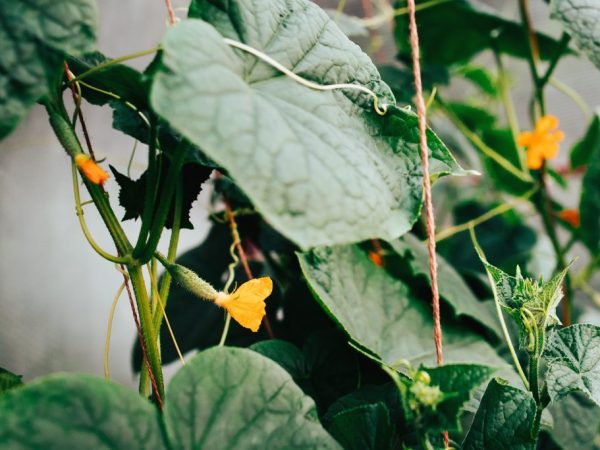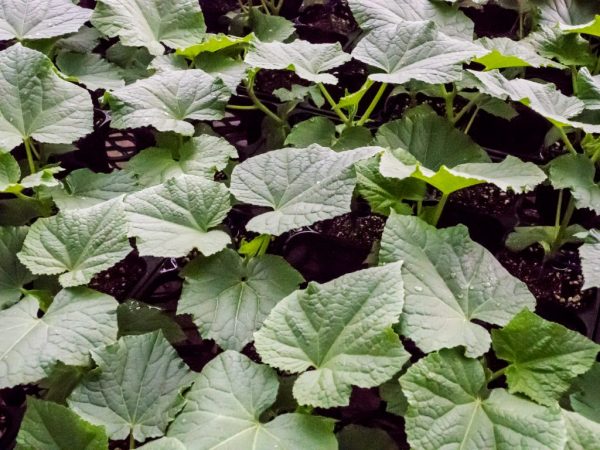Distance between cucumbers when planting
To get a good harvest of cucumbers, you need to know some rules and characteristics of varieties, as well as follow all the rules of cultivation. The distance between cucumbers when planting is one of the important factors.

Distance between cucumbers when planting
General rules of yield
Yield is influenced by many factors. Exogenous and endogenous. The first includes growing conditions, climatic zone, soil composition and agricultural technology features. Namely, planting methods and growing methods. Endogenous features include varietal characteristics and quality of seeds.
Only after the variety has been selected, the planting methods (seedling or seedling), the soil analysis is done, it is possible to decide at what distance to plant the cucumbers.
Remember that, ideally, the place (soil for planting cucumbers) should correspond to the acidity indicators of pH 7.
Variety selection
The variety must be chosen depending on the location of the farm, natural and climatic conditions, and the length of daylight hours. The varieties can be conventionally divided into three groups:
- greenhouse, with a fruit length of more than 30 cm;
- garden beds, planted in open ground, fruit length 10-15 cm;
- gherkins, no more than 10 cm in size.
The culture is divided into types according to the method of pollination into self-pollinating and cross-pollinating. Cross-pollinated plants have two varieties: insect pollination and wind-assisted pollination. The latter cannot attract insects with their flowers, but they emit a lot of pollen raised by the wind above the plants.
This factor is important for the further choice of planting method and determining the distance between the bushes.
Planting methods
The determination of the distance depends on the method of planting the cucumber crop. There are two main ways:
- seeds;
- seedlings;
When planting with seeds, in a seedless way, both dry and previously soaked in a nutrient solution are used. Cucumbers do not grow well in very acidic soils. They prefer alkaline, not waterlogged. Therefore, if the soil does not meet the standard, ash or fluff lime must be added to the garden bed. The root system of a cucumber crop with a weak sucking force. Therefore, soil moisture must be maintained at 70-80% HB.
Open ground can be sown in soil temperatures between 15 ° C-17 ° C. Prepared holes are placed in 1-2 rows. The sowing depth is 1-2 cm. After the sprouts appear, thin out. This will determine the distance between the bushes - 50-60 cm.
Seedlings are usually grown in a cassette manner. For the soil, soil mixtures, humus substrates, sod soil and sand are used. In each cell, a depression of 1.5-2 cm is made. It is sprinkled with soil on top. Water is poured abundantly. Seed germination temperature 18 ° C -24 ° C. If it is lower, the seeds germinate for a long time due to the dense shell.
After 22 days of age, the plants are transplanted into half-liter containers.For a good development of the root system, it is necessary to constantly maintain the water, temperature and light balance. Seedlings are planted directly in open ground at a soil temperature of at least 10 ° C -12 ° C.
Growing methods
There are several methods of growing cucumber, each of which has its own advantages and characteristics. These methods include:
- in raised (horizontal);
- on a trellis (vertical);
- in barrels;
- in warm beds.
Landing scheme for the horizontal method
When planting seedlings in spring, the plant density can range from 2.5 to 3 pieces. per sq. m. With an early disembarkation - 2.5 pcs. per sq. m, and for late up to 3 pcs. per sq. m. Placed in one or 2 rows. With one-sided placement, the distance in a row between cucumbers is from 60cm to 100cm. Between rows 80-100 cm.
With two-sided placement on a ridge, the bushes are planted in a checkerboard pattern. Between rows there is a gap of 60 cm, in a row between plantings 50-60 cm.
The use of sunlight and natural heat will be maximized. But it is difficult to care for the culture. The overgrown shrub covers all the soil around and prevents weeding and harvesting. It is better not to disturb the plant stems. Otherwise, the orientation of the leaves will be violated. This will delay fruiting.
Scheme for the vertical method

Trellis growing has many advantages
To get a good harvest, it is better to pay attention to another method, i.e. growing on a trellis. In this case, they are planted in two rows. Stakes are placed. Trellis wire is fixed to them from above. Use high and low trellises.
If the trellises are low, up to 0.5 m, the plants are not tied up. They are simply thrown over the wire. Using a high trellis, more than 1 m, cucumber bushes are formed into one stem and must be tied up with twine. The advantages of this growing method include the following factors:
- significant space savings;
- availability of care during the growing season;
- reduced risk of disease;
- good light conditions;
- airing;
- long-term fruiting;
- clean fruits in plain sight.
Bushes or seedlings are planted in 2 rows in a checkerboard pattern. The distance between the rows is 80 - 100 cm.After a certain distance, holes are made for planting cucumbers. The distance between them should be 30-40 cm.
Usually this method is used when grown in greenhouses or greenhouses. It is recommended to maintain a distance of at least 25 cm to the edge of the ridge. If the plants are located too close to the greenhouse wall, they may be poorly lit or exposed to frost. These negative factors will immediately affect their growth and development.
The chosen distance between the rows provides good ventilation, uniform supply of heat and light, unhindered access to planting, watering, care and collection of fruits.
Barrel diagram
The method of growing in any containers is quite popular. Common metal or plastic drums and containers are often used. When grown in such containers, they are filled with grass, manure and earth. Spill well and let stand for 1 week. Then 5-8 dry seeds are sown in each and covered. After the appearance of 3 leaves, props from arcs are installed and timely watering is provided. This method has the following advantages:
- compact placement;
- minimum labor costs when leaving;
- clean and beautiful fruits;
- aesthetic appearance (the lashes hang down to the ground, hiding the container);
- getting an earlier harvest.
In this planting method, the seeds are planted to a depth of 1-2 cm with a distance of 10 cm between them. It depends on the size of the barrel. You can plant cucumbers with saplings in barrels.
Scheme for planting in warm beds
Landing in warm beds in greenhouses is possible. One of the advantages is that you do not need to fiddle with the seedlings, replant them and wait for them to take root. An early harvest in this variant is ensured. This method is used by summer residents or in small farms.
For this method, you need to organize warm ridges, 30-40 cm high. In the middle, holes are made with a depth of 20 cm. Seedlings are planted in them. The distance between plants in a row is 30-40 cm.
Common mistakes
Any improper care of cucumbers, irregularities in watering, incorrect planting distance or lack of feeding, ultimately leads not only to a decrease in yield, but also to the complete death of plantings. Common mistakes include:
- poor quality seeds;
- non-compliance with sowing rules;
- wrong conditions;
- excess nutrients;
- an abundance of barren flowers.
All seed should be approximately the same size, i.e. calibrated. Freezing during storage is not allowed. Mandatory absence of any signs of disease. Presowing preparation includes soaking, hardening, processing with special preparations. If these conditions are not met, poor germination or developmental delay is possible.

Maintain your plants well
In case of incorrect sowing, even if all the seeds were selected with high quality, the desired result will not be. The correct formation of the beds, the distance maintained according to the technology, the heated soil, especially when planting directly into the open ground, will allow you to get many shoots. It is recommended to immediately eliminate all pathogens.
Each variety or hybrid has specific growing conditions. Therefore, before starting, you should carefully study them and find out all the features of this species. Respect the recommended spacing and care conditions for each planting method. For example, in order to get a good harvest from bee-pollinated varieties, you need to know that you cannot plant them in a greenhouse, that there are special requirements for the distance from the edge of the ridge to the walls of the greenhouse.
It is the wrong distance and poor quality planting material (fresh, poorly heated seeds of the last year) that lead to an abundance of barren flowers. This should be given special attention. Barren flowers are male flowers that cannot form fruit. This leads to a decrease in yield and quality of the final product.
Precautions
To prevent the appearance of a wasteland, you must:
- do not allow a tight fit;
- avoid thickening of the bushes;
- place crops in a shaded place;
- observe temperature and climatic conditions.
For 1 sq. M. there should be no more than 1-2 plants. Ensure that all bushes are ventilated and receive light evenly.
Diseases of cucumbers
Growing cucumbers in one way or another requires some work from gardeners. And failure to comply with at least one of the planting factors can lead to the disease of the entire crop. It is better to prevent the disease than to cure it later. An incorrectly chosen distance can lead to some diseases:
- lack or excess of moisture;
- lack of nutrients in the soil;
- pests.
When planted too densely, the plants overlap each other with leaves. Ventilation deteriorates. All moisture remains in the soil and contributes to the decay of the root system. A disease called root rot may develop. The lashes wither and then dry out completely, fruiting completely stops. To detect such a disease, you can only dig up the whole bush.
With a rare planting, the soil will dry out. Overheating of the rhizomes occurs, leading to a slowdown in the growth of the crop, up to its complete death.
High density of bushes per 1 sq. M. entails a lack of substances in the soil. The removal of useful elements from the soil by plants increases. This disturbs the balance of feedings. Leads to a shortage of crops or poor quality products.
A tight planting increases the risk of spreading various pests. Pests include: thrips, aphids, ticks, bedbugs. They damage the tops of the shoots. This leads to the formation of ugly ovaries and the death of leaves.When dealing with pests, the density of the standing makes spraying difficult. The leaves cover each other. The medicinal solution with fungicides cannot reach the entire stem
Conclusion
A stable, high-quality crop can be obtained only with the correct organization of all agrotechnical measures. Cucumber is one of the most popular, but also capricious crops.


